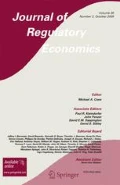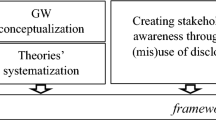Abstract
Who should be responsible for industry regulation, a private self-regulatory agency or a public agency? This paper provides a simple framework to analyze the optimal scope of a private self-regulatory organization (SRO) versus government regulation. The trade-off depends on three key elements: externalities, monopoly distortions, and the degree of asymmetric information. Self-regulation is more desirable than government regulation if the degree of asymmetric information between the public regulator and private industry is larger than the size of the monopoly distortion and externalities from the industry to society. An optimal mechanism consists of both self-regulation and government regulation where an SRO internalizes externalities within the industry and the government corrects any distortions generated by the SRO. These insights can be applied to many practical settings and policy discussions—for example, in the context of the financial sector, as with the Financial Industry Regulatory Authority.
Similar content being viewed by others
Notes
See “Remarks of Treasury Secretary Lawrence H. Summers to the Securities Industry Association” on Nov. 9, 2000 at http://www.treasury.gov/press-center/press-releases/Pages/ls1005.aspx.
See “Remarks of Lawrence H. Summers Director of the National Economic Council Responding to an Historic Economic Crisis: The Obama Program” on March 13, 2009 at https://www.brookings.edu/wp-content/uploads/2012/04/0313_summers_remarks.pdf.
For a detailed description for FINRA, see http://en.wikipedia.org/wiki/Financial_Industry_Regulatory_Authority.
Grajzl and Murrell (2007) also pursue the question of self-regulation versus government as an allocation of lawmaking power and identify conditions for improving social welfare.
To simplify analysis, I do not provide a micro-foundation for such externalities. In the applications, I provide examples to illustrate how such externalities might evolve.
It is the producers who should bear the blame for over-production because the externality term depends on total production by assumption. However, total production equals total consumption in equilibrium. Furthermore, it is possible that consumers are also responsible for the inefficiency if the externality term depends on total consumption.
Indeed, correcting externalities to consumers requires a reduction in production, the same result when the SRO exerts monopolistic distortion. However, the magnitude of reduction in production might differ. Furthermore, depending on assumptions, correcting externalities to consumers might call for an increase in production.
Similarly, one could ask the question of whether government regulation (self-regulation) is desirable compared to the unregulated competitive equilibrium. I answer this question by introducing the relative welfare function \(\Delta ^{CE/G}\) in Online Appendix.
See Online Appendix for details.
Similarly, one can show that the self-regulation does not automatically dominate competitive equilibrium, especially when the \(\Delta ^{S/G}<\Delta ^{CE/G}\).
One direct implication is that government can regulate both the consumers and producers to implement the first best allocation. For simplicity, Proposition 1 only considers regulations either on consumers or producers. For the analysis below, I focus on the regulations on the producer side.
In Armstrong and Sappington (2007), they summarize the insights about regulating a monopoly and claim that the first best can be implemented if the regulator knows consumer demand. Here in my settings, if the government knows the demand parameter \(\phi \), it can only implement the second best since the government also needs to know the externality parameter \(\Phi \).
For the nuclear industry, the competitor is the traditional power industry. For the securities industry, consumers can simply withdraw their money and put into a traditional banking account.
The externalities are even larger given the existence of deposit insurance and bailout funds.
For example, see the debate on how to regulate the Facebook in https://www.ft.com/content/0f2c8952-a719-11ea-92e2-cbd9b7e28ee6.
Think about the services provided by Google and Facebook. For the self-driving cars, consumers can always choose to drive by themselves.
Here, the interest rate R can be normalized to 1 due to the specific setting of an investor’s utility function.
References
Aboura, S., & Lepinette, E. (2014). A model of self-regulation in banking industry. Working Paper.
Armstrong, M., & Sappington, D. E. M. (2007). Recent developments in the theory of regulation. Handbook of Industrial Organization, 3, 1557–1700.
Baron, D. P., & Myerson, R. B. (1982). Regulating a monopolist with unknown costs. Econometrica, 50(4), 911–930.
Bernanke, B. S. (1983). Nonmonetary effects of the financial crisis in propagation of the great depression. American Economic Review, 73(3), 257–76.
Bianchi, J. (2011). Overborrowing and systemic externalities in the business cycle. American Economic Review, 101(7), 3400–3426.
Bianchi, J. (2016). Efficient bailouts? American Economic Review, 106(12), 3607–59.
Carson, J.W. (2011). Self-regulation in securities markets. World Bank Policy Research Working Paper No. 5542.
DeMarzo, P. M., Fishman, M. J., & Hagerty, K. M. (2005). Self-regulation and government oversight. Review of Economic Studies, 72(3), 687–706.
Dogra, K. (2014). Liquidity traps, debt relief, and macroprudential policy: A mechanism design approach. Working Paper.
Farhi, E., & Tirole, J. (2012). Collective moral hazard, maturity mismatch, and systemic bailouts. American Economic Review, 102(1), 60–93.
Gehrig, T., & Jost, P.-J. (1995). Quacks, lemons, and self regulation: A welfare analysis. Journal of Regulatory Economics, 7(3), 309–325.
Grajzl, P., & Murrell, P. (2007). Allocating lawmaking powers: Self-regulation vs government regulation. Journal of Comparative Economics, 35(3), 520–545.
Jeanne, O., & Korinek, A. (2010). Excessive volatility in capital flows: A Pigouvian taxation approach. American Economic Review, 100(2), 403–07.
Jeanne, O., & Korinek, A. (2019). Managing credit booms and busts: A Pigouvian taxation approach. Journal of Monetary Economics, 107, 2–17.
Keister, T. (2015). Bailouts and financial fragility. Review of Economic Studies, 83(2), 704–736.
King, A., Prado, A., & Rivera, J. (2011). Industry self-regulation and environmental protection. In A. J. Hoffman & T. Bansal (Eds.), Oxford handbook of business and the environment. Oxford: Oxford University Press.
Kondo, J. (2007). The self-regulation of enforcement: Evidence from investor-broker disputes at the NASD. Technical Report, Working Paper, Boston: MIT.
Laffont, J. J. (1977). More on prices vs. quantities. Review of Economic Studies, 44, 177–182.
Leland, H. E. (1979). Quacks, lemons, and licensing: A theory of minimum quality standards. Journal of Political Economy, 87, 1328–1346.
Lyon, T. P., & Maxwell, J. W. (2003). Self-regulation, taxation and public voluntary environmental agreements. Journal of Public Economics, 87(7), 1453–1486.
Lyon, T.P., & Maxwell, J.W. (2012). Self-regulation, negotiated agreements and social welfare. Working Paper.
Ma, C. (2020). Financial stability, growth and macroprudential policy. Journal of International Economics, 122, 103259.
Ma, C., & Wei, S.-J. (2020). International equity and debt flows: Composition, crisis, and controls. NBER Working Paper No. 27129.
Ma, C., & Nguyen, X.-H. (2018). Too big to fail and optimal regulation. Working Paper.
Maxwell, J. W., Lyon, T. P., & Hackett, S. C. (2000). Self-regulation and social welfare: The political economy of corporate environmentalism. Journal of Law and Economics, 43(2), 583–618.
Núñez, J. (2001). A model of self-regulation. Economics Letters, 74(1), 91–97.
Núñez, J. (2007). Can self regulation work?: A story of corruption, impunity and cover-up. Journal of Regulatory Economics, 31(2), 209–233.
Perottia, E., & Suarezb, J. (2011). A Pigovian approach to liquidity regulation. International Journal of Central Banking, 7(4), 3–41.
Pirrong, S. C. (1995). The self-regulation of commodity exchanges: The case of market manipulation. Journal of Law and Economics, 38, 141–206.
Rebucci, A., & Ma, C. (2020). Capital controls: A survey of the new literature. Oxford Research Encyclopedia of Economics and Finance.
Shaked, A., & Sutton, J. (1981). The self-regulating profession. Review of Economic Studies, 48, 217–234.
Shapiro, C. (1986). Investment, moral hazard, and occupational licensing. Review of Economic Studies, 53(5), 843–862.
Stefanadis, C. (2003). Self-regulation, innovation, and the financial industry. Journal of Regulatory Economics, 23(1), 5–25.
Weitzman, M. L. (1974). Prices vs. quantities. Review of Economic Studies, 41, 477–491.
Author information
Authors and Affiliations
Corresponding author
Additional information
Publisher's Note
Springer Nature remains neutral with regard to jurisdictional claims in published maps and institutional affiliations.
I am grateful to Anton Korinek, Olivier Jeanne, Laurence Ball, and Jon Faust for their encouragement and stimulating discussions. All errors are my own. I acknowledge financial support sponsored by Shanghai Pujiang Program.
Rights and permissions
About this article
Cite this article
Ma, C. Self-regulation versus government regulation: an externality view. J Regul Econ 58, 166–183 (2020). https://doi.org/10.1007/s11149-020-09415-y
Published:
Issue Date:
DOI: https://doi.org/10.1007/s11149-020-09415-y




